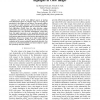Free Online Productivity Tools
i2Speak
i2Symbol
i2OCR
iTex2Img
iWeb2Print
iWeb2Shot
i2Type
iPdf2Split
iPdf2Merge
i2Bopomofo
i2Arabic
i2Style
i2Image
i2PDF
iLatex2Rtf
Sci2ools
108
click to vote
ICRA
2003
IEEE
2003
IEEE
A truncated least squares approach to the detection of specular highlights in color images
— One of the most difficult aspects of dealing with illumination effects in computer vision is accounting for specularity in the images of real objects. The specular regions in an image are often saturated - which creates problem for all image processing algorithms that use decision thresholds. Such algorithms include those for edge detection, region segmentation, etc. Detecting specularity and whenever possible compensating for it are obviously advantageous. Along these lines, this paper represents a new specularity detection and compensation method which is based on the notion of truncated least-squares approximation to the function that maps the color distribution between two images of an object under different illumination conditions. We also present a protocol for the evaluation of the current method for specularity detection. Our protocol as currently formulated uses human subjects to grade the specularity detection method.
ICRA 2003 | Image Processing Algorithms | Robotics | Specularity Detection | Specularity Detection Method |
| Added | 04 Jul 2010 |
| Updated | 04 Jul 2010 |
| Type | Conference |
| Year | 2003 |
| Where | ICRA |
| Authors | Jae Byung Park, Avinash C. Kak |
Comments (0)

